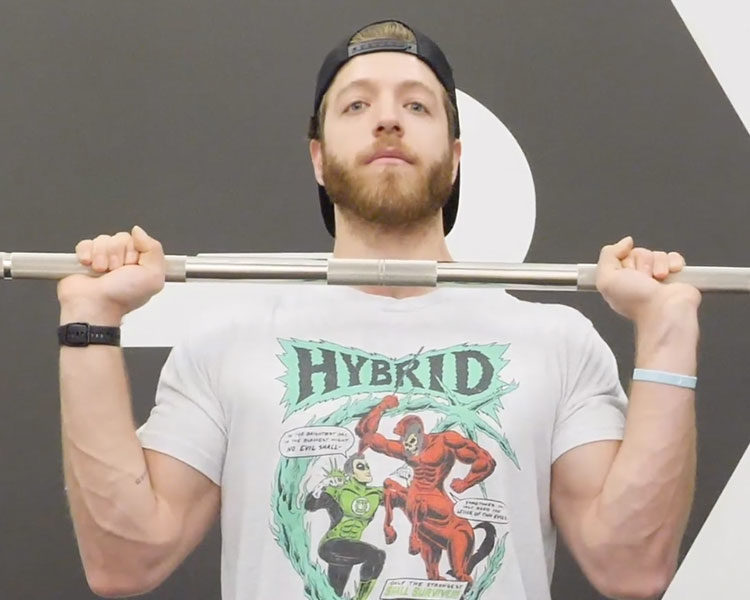When you’re painting furniture, cupboards, or the exterior of your house, you want it to look good. And for it to look good, you can’t just slap a coat of paint on. You need to prepare the surface for the paint. You need to prime it for the paint to be effective.
The same could be said for your big lifts.
If you want to crush your training, consider adding an exercise primer before you lift serious weight. The painting can wait. You’ve got strength to gain.
… The painting is the heavy lifting and the priming is the right warm-up move, OK? Don’t think too much about the metaphor, just think about these exercises.
Editor’s note: This article is an op-ed. The views expressed herein and in the video are the author’s and don’t necessarily reflect the views of BarBend. Claims, assertions, opinions, and quotes have been sourced exclusively by the author.

What Is an Exercise Primer?
Before you perform a big lift or take on a difficult-to-build muscle group, you do an exercise that fires up the muscles you plan on attacking, essentially priming the muscles for the work ahead.
Here are three reasons to include them in your training.
1. To get your body ready for the big lifts
Explosive exercises (med ball throws) and plyometrics are great exercise primers because, by activating your fast twitch muscles, they help prepares your body for the load on the bar and unlock your strength before you attempt the big lift.(1)
I know, I keep talking in metaphors here, but fast twitch muscle fibers are very active during heavy lifts, and priming them with quick, explosive movements before things get heavy can be a smart way to prep. For example; A jump squat before a barbell squat.
These are best used when maximal strength and power is your goal.
2. Lubricate the joints and prepare the stabilizing muscles
An exercise primer acts as extended “warm up,” lubricating joints and activating specific muscles before challenging your body with the barbell. For example; before squats and deadlifts, you can try hamstring curls on a stability ball.
This helps lubricate the hip and knee joints while firing up the stabilizing muscles that play a role in the movements of the squat and hinge.
Best used if you’re an older lifter with a few miles on your joints.
3. Helping the mind muscle connection
Some lifters have trouble ‘feeling’ a muscle working during a lift. For example; the lats during a deadlift or the chest during a bench press. If this sounds like you, using an isolation exercise before you lift can help you better feel those muscles working.
For example: straight-arm lat pulldown before deadlifts or chest flyes before bench pressing.
This is best used when hypertrophy is your goal.
Hopefully I’ve convinced you that primers are a great way to make your training more effective. Here are some examples to use in your training pronto.
Upper body primers
Especially for overhead pressing, prime (and lubricate) the stabilizers of the shoulders, rotator cuffs, and upper back for a pressing session with the banded pull-apart or a cable face-pull.
For example,
- 1A. Cable face pull 12-15 reps
- 1B. Bench press 4-12 reps
Or before any pulling movements on back day, a great way to prime the back is the straight-arm pulldown or its variations. For example;
- 1A. Straight arm pulldown 8-12 reps
- 1B. Bent over row or chin up 6-12 reps
Or if maximal strength is your goal, including a plyometric exercise or med ball throw is a great way to prime your fast twitch muscles fibers for action. For example:
- 1A. Plyometric push up 3-6 reps
- 1B. Bench press 3-6reps
Lower body Primers
Get some blood moving through the hip and knee joints before you squat, deadlift, or lunge to help aching joints or to better establish a better mind body connection. For example:
- 1A. Stability ball hip extension hamstring curl 8-12 reps
- 1B. Barbell squat variation 6-12 reps
Note: any machine/hamstring curl variation will work here.
Or, say you have trouble feeling your glutes or quads ‘switch on’ during squats. If you want to create a better mind body connection with them, consider one of these supersets.
- 1A. Single leg hip extensions 8 reps each side
- 1B. Deadlift or squat variation 6-12 reps
Or
- 1A. Leg extensions 12-15 reps
- 1B. Front or back squat 6-12 reps
And if you’re training for maximal strength with your squats or deadlifts, lower body plyometrics will prepare your fast twitch muscles for the heavy load you’re about to crush. For example;
- 1A. Bodyweight squat jump 3-5 reps, rest 1-2 minutes
- 1B. Barbell front or back squat 3-5 reps, rest 1-2 minutes
Or if you want to get a little technical…
- 1A. Resisted broad jump 3-5 reps, rest 1-2 minutes
- 1B. Deadlift 3-5 reps, rest 1-2 minutes
Wrapping up
Extending your warmup and paying extra attention to your joints and muscles before hitting the barbell can help your lifting numbers and can ease the strain on older joints.
Now you can get back to painting.
Except that lifting is more enjoyable than painting, so maybe you can insert your own metaphor here.
Featured image via UfaBizPhoto/Shutterstock
References
- McBride JM, et al. The effect of heavy- vs. light-load jump squats on the development of strength, power, and speed. J Strength Cond Res. 2002 Feb;16(1):75-82.

